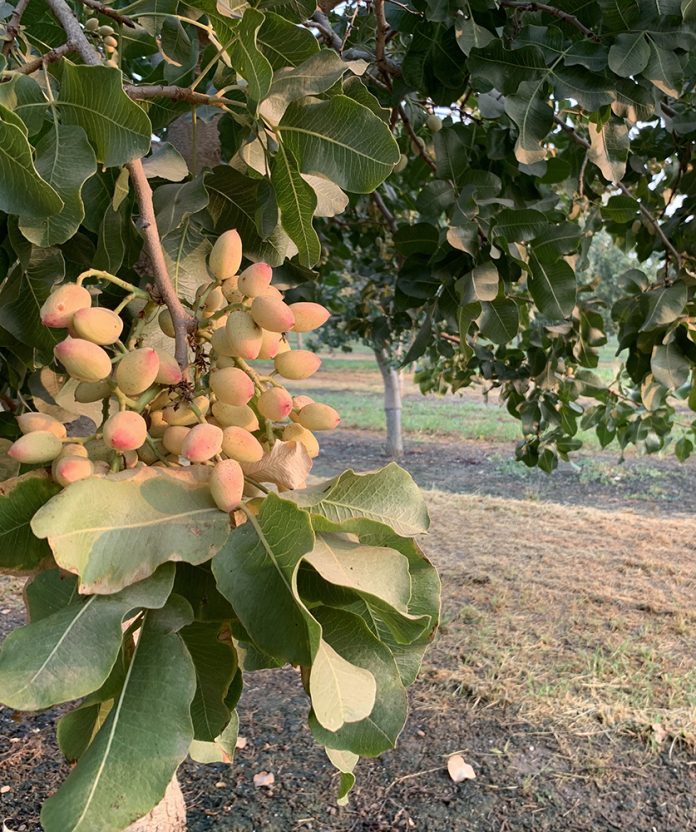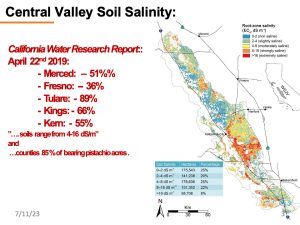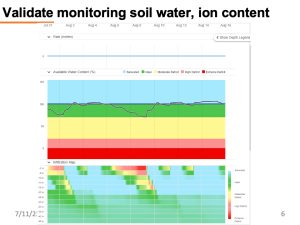
According to the California Water Research Report on Apr. 22, 2019, 51% of Merced, 36% of Fresno, 89% of Tulare, 66% of Kings and 55% of Kern counties have soils that range from moderately saline (4 dS/m) to extremely saline (16 dS/m). Approximately 85% of California’s pistachio bearing acreage are in these counties (Figure 1). Retired Kern County Farm Advisor Blake Sanden and statewide Specialists Louise Ferguson and Giulia Marino have demonstrated pistachio can produce well in moderately saline soils with rootzone salinities (ECe) between 4.5 to 6 dS/m.

Currently, the most used salinity and boron management method is to leach in the winter with 1 to 2 acre-feet of good-quality water by flood or sprinkler irrigation. As the availability of high-quality canal water for in-season irrigation and dormant season leaching declines, growers are relying more on semi-saline pumped groundwater, particularly in the western San Joaquin Valley. It would be helpful to know if the volume of dormant-season leaching could be reduced, if in-season methods of leaching could be effective, and how to use moderately saline water most efficiently for both dormant and in-season leaching. It is also not known if a single or double-line drip, delivering the same volume of water in the same amount of time, could more efficiently lower soil salinity in the rooting zone.
Real-time monitoring of available water content (AWC) and soil salinity in the root zone (ECe) could facilitate efficient irrigation and salinity management by informing irrigation scheduling of normal irrigation according to evapotranspiration, irrigation with in-season leaching fraction and dormant leaching. Sensors to continuously monitor AWC and ECe in real time are now available and can be used to monitor the soil profile in the drip-wetted rootzone.
Large-Scale Trial
A cooperation among Maricopa Orchards, Semios, Ceres Imaging and Dellavalle Laboratories in a large-scale drip irrigation trial at Five Points, Calif. in Maricopa Orchards Mt. Whitney Ranch seeks to develop a system to monitor and ameliorate soil salinity, ECe.
The objectives of this trial are to:
- Determine the most efficient salinity irrigation management practices for drip-irrigated pistachio trees in saline soils with moderately saline water supplies;
- Determine if newer monitoring methods can facilitate salinity management;
Develop grower-friendly tools/calculators to help growers manage salinity under increasing limitations imposed by the Sustainable Groundwater Management Act (SGMA).
The study is in an orchard that was planted in 2015 with field-budded Golden Hills on cloned UCBI rootstocks spaced at 18 x 20 feet, with 121 trees per acre (Figure 2). The soil is a silty clay loam saline-sodic Cerrini complex with salinity ranging from 3 to 15 dS/m, pH 7.5 to 8.2, boron levels of 3 to 12 ppm and soil sodium levels ranging from 16 to 130 meq/l (370 to 3000 ppm). The field has salinity, boron and sodium levels that decrease from north to south and increase the generality of results by incorporating changes in soil texture. In-season irrigation water consists primarily of ground water with 2.5 to 3.0 dS/m EC (1600 to 1900 ppm). Baseline boron leaf levels measured in August 2022 averaged over 1500 ppm while sodium leaf levels were below detectible levels. Levels of other nutrients in leaves were within normal ranges.

The trial is designed to determine if a double or single hose configuration, delivering the same amount of water in the same amount of time with or without a 15% in-season leaching fraction and combined with or without dormant-season pulsed in-row leaching, can manage root zone salinity that results in better growth, yield and nut quality.
To investigate the effects of the leaching treatments we have significant help from our industry cooperators. Dellavalle Laboratories provided the baseline and is continuing soil and tissue sampling. A wireless network of sensors comprised of soil moisture probes, dendrometers, weather stations and pressure transducers was installed and is being managed by Semios on an ongoing basis. The soil moisture probes provide high temporal resolution of available water content (AWC) and volumetric ionic content (VIC) observations across 12 depths along the soil profile. The dendrometers measure microvariations in trunk diameter to assess water status of an individual plant, and the pressure transducers measure lateral line pressure at each experimental unit to track and measure irrigation volumes and timing applied to them. Ceres Imaging is providing aerial monitoring for the Normalized Differential Vegetative Index (NDVI). NDVI measures the difference between visible and near-infrared (NIR) light reflectance from vegetation to create a snapshot of photosynthetic vigor. Vegetation in a vigorous canopy will absorb visible light and reflect most NIR light whereas a sparse canopy will reflect more visible light and less NIR light. Ceres Imaging’s aerial technology also monitors water stress, canopy growth and leaf chlorophyll content. We are doing EM38 measurements of soil ECe and physiological measurements, including stem water potential, photosynthesis and stomatal conductance. Growth is being measured by trunk diameter and low altitude drone flights. An annual harvesting and sample grading are measuring yield and nut quality. Figure 3 shows the methods of data collection.

Preliminary Results
Preliminary results suggest all leaching treatments (15% in-season leaching, dormant leaching and the combination of both, applied with both single and double hose lines) significantly decreased soil ECe relative to the control. On average, ECe in all the treatments declined by an average of 16% relative to their respective controls. All the leaching treatments also significantly prevented boron from accumulating in the soil relative to the control. No clear effects of line configuration, double versus single line, were detected.
These preliminary results indicate treatments are effective in reducing salinity or at least preventing the increases observed in the control. Although generally representative, these results are based on averages across the number of lines, positions and depths. Significant interactions that were detected but not described here indicate treatment effects can vary depending on distance from the emitter and depth in the soil.
New In Situ Soil Water and Salinity Monitoring Technology
In addition to using new technologies as research tools, this project is investigating the feasibility of growers using these technologies as aids for irrigation management in saline situations.
We are investigating the use of Semios’s platform of integrated sensors as a soil monitoring system in this context. An example is given in Figure 4 of how Semios’ user interface provides a real-time view of the available water content (AWC). To further this, the data is also delivered in a manner that allows the user to perceive both infiltration and rootzone consumption over time. Using these values in coordination with changes in volumetric ionic content (VIC), a grower can begin to determine the impacts of their leaching strategies and whether they are likely to maintain or decrease the ECe.

Accompanying this data with monthly aerial imaging can enhance soil profile monitoring by documenting the effects on canopy growth, vigor, and water stress status. Figure 5 shows a Ceres Imaging aerial image of orchard stress and vigor.

The main objective of this project is to create a grower-friendly tool to calculate the most efficient way to maintain soil salinity between 4.5 to 6.0 dS/m in the San Joaquin Valley under drip irrigation using moderately saline water supplies. We are also evaluating the impact of single- versus double-line drip to manage root zone salinity and boron using different leaching methods. After one season, results demonstrate in-season leaching has potential to decrease or prevent increases in salinity in moderately saline-sodic soils, using moderately saline irrigation water with both single- and double-line drip systems.
Novel in situ monitoring systems and aerial whole orchard monitoring have potential to enhance management of irrigation when available water is moderately saline.
Detailed results after one complete experimental season will be presented and discussed in the Salinity Management in Pistachio Workshop at the Kearney Agricultural Center, 9240 South Riverbend Ave., Parlier, CA on Wednesday Dec. 13, 2023 from 8:00am to 12:00pm. For more information, contact LFerguson@ucdavis.edu.
We gratefully acknowledge the significant cooperation of Maricopa Orchards, Semios, Ceres Imaging and Dellavalle Laboratories and the funding support of the California Pistachio Research board and the California Department of Food and Agriculture.
















